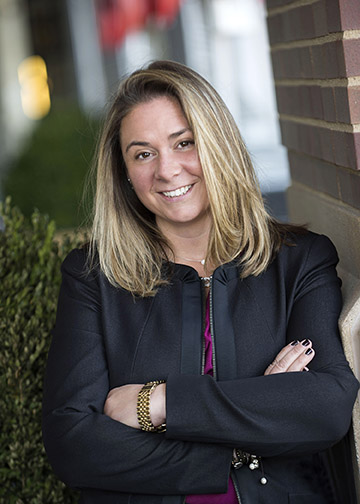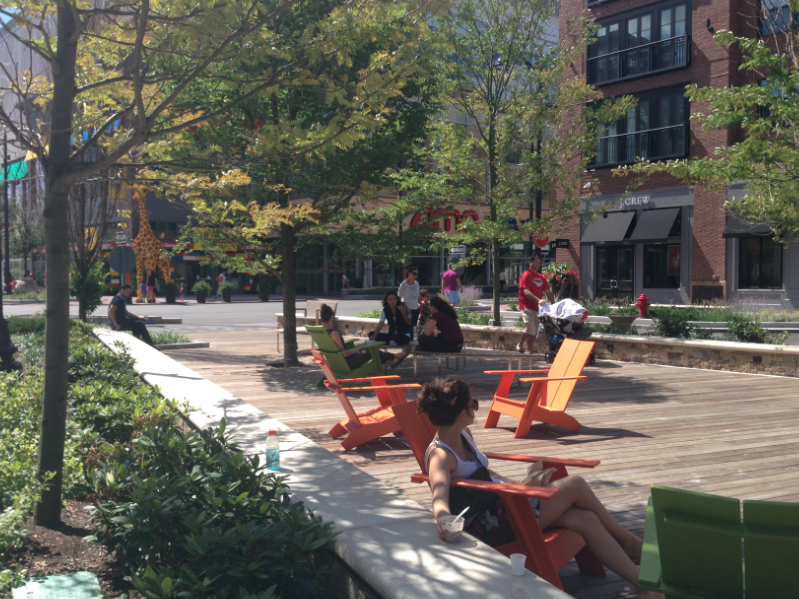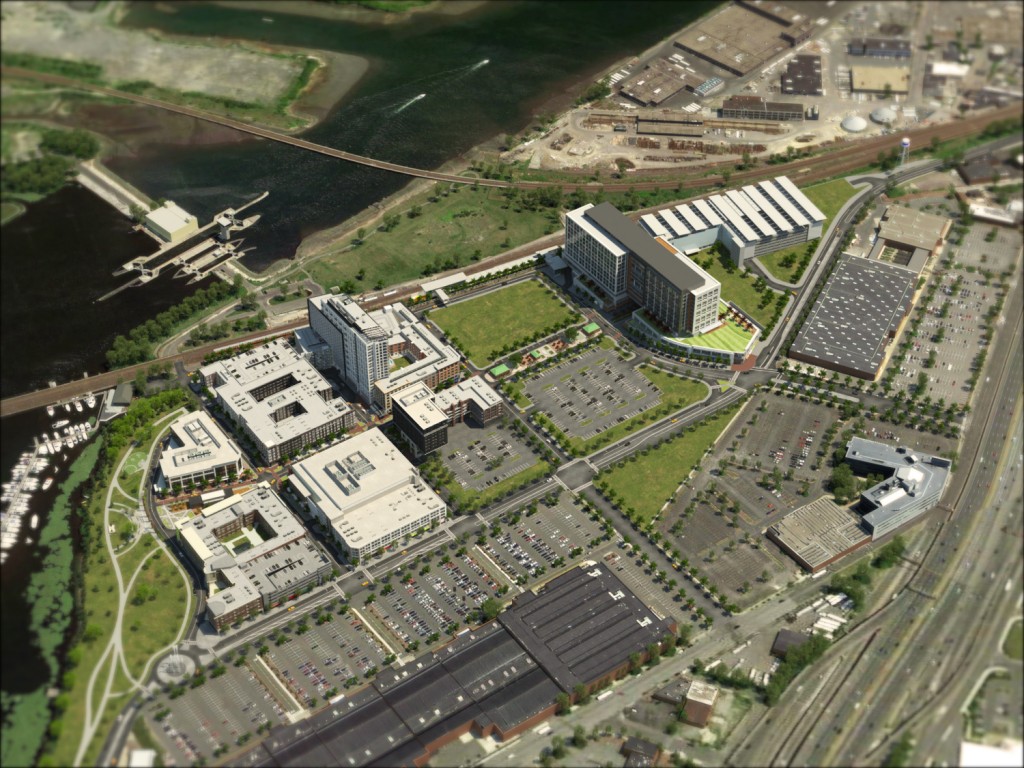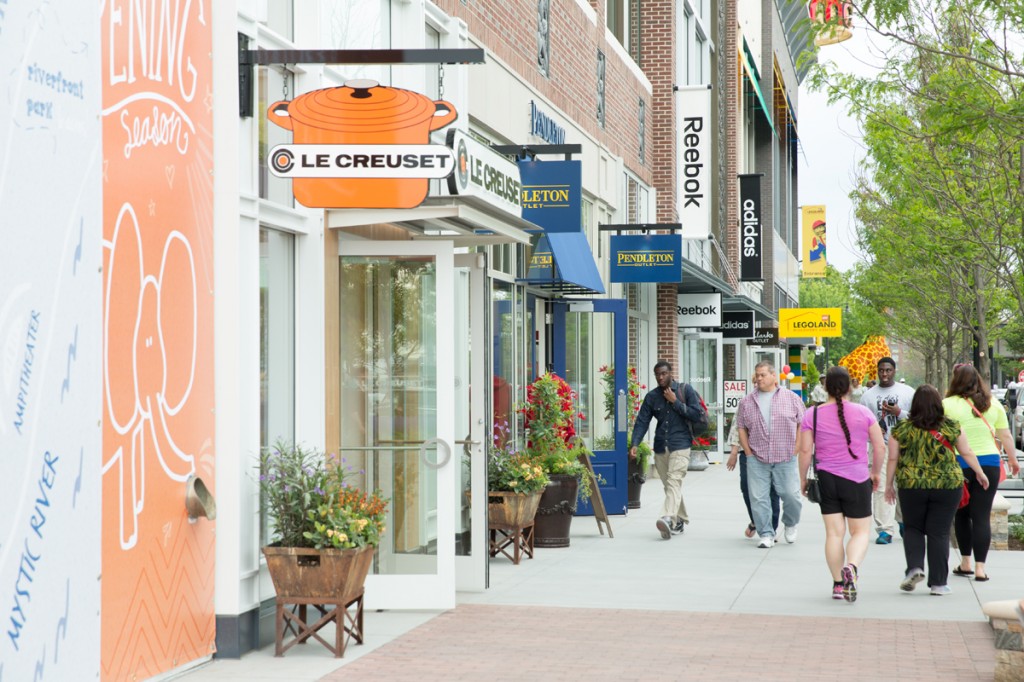 (The view of Assembly Row from Sylvester Baxter Riverfront Park)
(The view of Assembly Row from Sylvester Baxter Riverfront Park)
Over the summer, Assembly Row celebrated its grand opening in Somerville. A movie theater, LEGOLAND Discovery Center, apartments, office space, shops and restaurants currently populate the previously undeveloped area, drawing customers of all kinds. In a few years, the area will look completely different. What we see now is just phase one of Assembly Row — and at least two more phases will be plotted and realized over the coming years.
The phases of development represent the long-term vision that Federal Realty, the developer responsible for Assembly Row, has for the area. Upon first glance, you might write off Assembly Row as a sterile, consumeristic playground. What the team at Federal Realty hopes you’ll see in a matter of years is Somerville’s next full-fledged neighborhood — one they’re creating from nothing, right out of the ground.
A new neighborhood doesn’t get built overnight: Just look at Boston’s Innovation District.
If you visit Assembly Row by car on a Saturday afternoon, you’ll likely have difficulty finding a place to park. Assembly, the first new MBTA station in 27 years, however, is up and running. Once there, you’ll wait at one of the restaurants for a lunch table and you’ll wait again when you go to check out at the J.Crew outlet. The area has succeeded in drawing customers in its first year, to put it modestly.
“It feels like Black Friday everyday,” said Andi Simpson, Federal Realty’s director of marketing. “Traffic is robust.” (Simpson couldn’t disclose retailers’ specific sales figures.)
But Assembly Row is more than an outlet mall; it’s a place people can also live and work – and a $1.5 billion project. Currently, the area contains 445 apartments, 335,000 square feet of retail space and 100,000 square feet of office space. When the development is complete, it will comprise 1,800 apartments, 635,000 square feet of retail space and 2.8 million square feet of office space.
Totaling 5.7 million square feet, Assembly Row is shaping up to be Federal Realty’s ($FRT) most ambitious project yet. The development company has 87 properties in its portfolio, mostly shopping centers, in 13 states and D.C. Their largest mixed-use development to date is Santana Row, a 650,000-square-foot development in San Jose, Calif., where Federal is now adding office space.
Simpson stressed the company spends time ensuring their new developments are what’s right for a particular area. So three years ago, Simpson, a Massachusetts native, went to Somerville: She attended the Fluff Festival, Artbeat and more events, talking to people about what additions and new amenities they might be looking for in their city.

After gathering some research, Simpson said Federal Realty decided it had to build a neighborhood — a “great environment.”
“The fun part is, how do you create something out of nothing?” Simpson said. “How do you insert a soul, or try to knit together the fiber that will become the DNA? Because nothing happens overnight.”
Not only does building a new neighborhood not happen overnight, it’s a tricky, ongoing effort to entwine a recent development into the makeup of a city that already exists. Look at Boston’s Innovation District, for instance. Condos and office spaces may be popping up in the area, but it can still feel desolate, especially on the weekends. As architecture critic Robert Campbell recently wrote in The Boston Globe, the neighborhood “needs a human touch,” partially crediting the wide, empty streets that the buildings face for the lack of invigorating city buzz.
At Assembly Row, the streets were a main focus of the development. According to Simpson, the first level of every Assembly Row block will feature storefronts and restaurants; apartments and office space will be built up, away from the streets.
The project, designed to make use of the industrial land along the Mystic River, is a deliberate one that’s been years in the making, and Somerville’s Mayor Joe Curtatone believes it’s paying off for the community. When asked about the changes happening now, the mayor, a lifelong city resident elected in 2003, stood behind the development’s slow build.
“I’m proud. It’s really a testimony to the community’s long-term dedication,” Curtatone said during a phone call with BostInno. “We’re not playing the short game; there will be no big box stores or casinos. It’s a more sustainable model that leverages the assets of the Mystic River, and we’ll be able to build Somerville’s next neighborhood.”
He also referenced a metaphor he’s used frequently over the years: Curtatone said he sees Somerville as a necklace, with each square in the city as one of its charms.
“This is another charm,” the mayor said. “And it’s just now scratching the surface.”
 (The seating area outside of JP Licks)
(The seating area outside of JP Licks)
Part of the reason why Assembly Row’s development is divided into phases is so Federal Realty has the opportunity to gauge what’s working and what isn’t, and how to make the smartest moves toward that true neighborhood. Federal Realty owns 66 acres in Assembly Square; in addition to the stores, restaurants and more currently standing (two buzzy businesses, River Bar and American Fresh Taproom, opened in the past two weeks), they plan to add a boutique hotel, a gym, and more office space, retail, apartments and restaurants, totaling the square footage mentioned above. A large portion of one of Assembly Row’s current parking lots will vanish, and the neighborhood will fill out.
One aspect of the development that Simpson and the Federal Realty team has noticed and plans to change moving forward? The sidewalks.
“One of the things we noticed is strollers,” said Simpson. “There are so many young families who live in Somerville and Charlestown, and they’re bringing strollers. So it’s about making sure the sidewalks are wide enough.”
In deciding what type of retail and restaurant landscape should define Assembly Row, Simpson said it was the result of planning that took place at the time the Great Recession hit. Currently, a majority of the neighborhood’s retail stores are outlets — an intentional move. According to Simpson, they didn’t want Assembly Row’s stores to compete with the mom-and-pop shops and boutiques that already make up the existing Somerville neighborhoods of Davis Square and Union Square. They also didn’t want to bring in high-end retailers during a time that, thanks to the recession, “everyone was asking what the value was of anything.” The outlet stores, which now include J.Crew, Nike, Banana Republic, Saks Off Fifth and more, seemed to be the best solution. And, as Simpson said, “It’s paid off.”
As construction continues, the area will not only look different than it does today, but completely unrecognizable from what it was in the past. Assembly Square, cut off from the rest of Somerville by I-93 and from Malden and Medford by the Mystic River, has been known as an industrial area with no residents — only really attracting those visiting the strip stores pre-dating Assembly Row (KMart, Bed Bath and Beyond, Sports Authority and more, referred to as Assembly Square Marketplace), or members of the Winter Hill Yacht Club.
Below is a rendering of what the neighborhood could look like after phase two is complete over the next few years.
 (Renderings that illustrate what phase two of Assembly Row’s development could look like.)
(Renderings that illustrate what phase two of Assembly Row’s development could look like.)
And as the area moves toward becoming a recognized, if not geographically contiguous, part of Somerville, the developers hope to demonstrate both a boost for the city’s employment, as well its affordable housing quota. Those two topics are a main focus of the Somerville Community Corporation (SCC), a community development corporation that preserves and maintains the economic diversity of Somerville. In its opening year, Assembly Row has hosted job fairs specifically for Somerville residents, and added 50 to 60 affordable housing units, about 12.5 percent of their total current housing. So far, these efforts have earned approval from the SCC’s Executive Director Daniel LeBlanc, but with some reservation.
“It’s great, you can build a whole new neighborhood…But we do worry about the impact of upscale development.”
“The fact that Assembly Square is being developed in a part of the city that is isolated from the rest kind of makes it like, ‘Oh it’s great, you can build a whole new neighborhood,’ which is what they’re doing and that part is exciting,” said LeBlanc. “But we do worry about the impact of upscale development on the rest of the housing market in Somerville.”
LeBlanc added that, when it comes to creating jobs for Somerville residents, he hopes the Assembly Row team doesn’t treat that as a “one-time thing, and let it fall to the wayside.”
“There are going to be more jobs available,” he said, “and there will always be people in Somerville who need jobs.”
Despite those worries, LeBlanc said he’s seen the area attract a “healthy mix” of people — “whom we would call Somerville people” — and he’s excited to see them flock to an area in the city that was underused just three to four years ago.
In its first year, the Assembly Row team has attracted people not just for its amenities, but for a wide mix of events. The area has hosted the Somerville Food Truck Festival, which attracted 18,000 guests (three times as many as were expected); Row It Forward, a weekend-long charity event that turned dollars spent into donations for local nonprofits; and Riverfest, which just celebrated its seventh year, predating the development’s construction. Simpson called it a “great tradition” that brings people to the waterfront.
The events demonstrate part of Federal Realty’s efforts to make Assembly Row a Somerville neighborhood, by spending time bringing local color to the area. Aside from the large-scale, annual events like Riverfest, Assembly Row has hosted recurring events, like art lessons, a handmade arts market, outdoor movies on the waterfront, yoga classes and a run club, the latter of which the Reebok and Nike outlets host each week. Simpson sees this interest in extracurricular activities as a sign the stores are performing better than expected in the new space.
(Those who enjoyed Assembly Row’s summer season of events can look forward to a winter season over the coming months.)
Of course, only time will tell how these event series help ease the notion of a new city neighborhood into the minds of the public, but that’s something Simpson expects as they work toward bringing that idea to fruition.
“Neighborhoods get even better and better over time,” she said. “We’re really looking forward to growing in Somerville.”
As for Mayor Curtatone, the current construction – and growth – is a sign of payoff, and of the community’s vision on its way to becoming a reality.
“It’s about chasing the dream,” he said. And he’s excited to see it come alive.
You can follow Assembly Row on Facebook and Twitter, and learn more about the neighborhood here.
All images provided by Assembly Row

